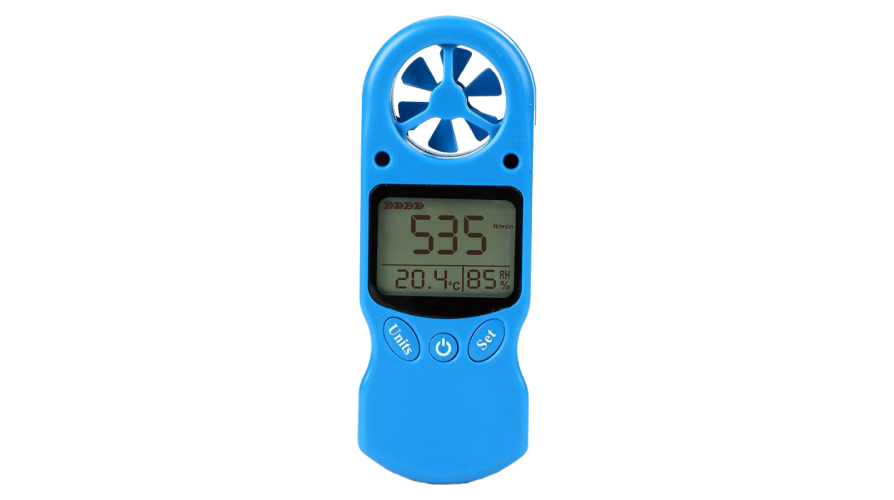Top Functions to Seek in a Reliable Anemometer for Accurate Wind Measurement
Wiki Article
Checking Out the Functions and Advantages of Anemometers for Climate Enthusiasts and Professionals
Anemometers stand as important tools in the realm of weather monitoring, accommodating both lovers and experienced experts alike. These devices provide a window into the dynamic world of wind patterns and rates, giving invaluable data for atmospheric evaluation and forecasting. From cup anemometers to sonic anemometers, each type brings its unique collection of applications and benefits, clarifying numerous elements of weather. As we dive right into the functions and advantages of anemometers, a deeper understanding arises not only of prevailing weather phenomena but also of the broader implications for sectors like wind power manufacturing and environmental research.Relevance of Anemometers in Weather Condition Monitoring
Anemometers play an important role in climate surveillance by supplying accurate dimensions of wind rate, helping in projecting and understanding weather patterns. These instruments, varying from conventional mug anemometers to modern ultrasonic anemometers, are crucial for meteorologists, researchers, and weather enthusiasts alike. By determining wind rate, anemometers help in establishing the intensity of weather condition sensations such as storms, twisters, and storms. Additionally, they supply useful data for air travel, maritime procedures, and different markets that are delicate to wind problems.
Sorts Of Anemometers and Their Applications
The most usual types of anemometers include mug anemometers, vane anemometers, hot-wire anemometers, and ultrasonic anemometers. Cup anemometers are composed of three or 4 cups placed on horizontal arms that rotate with the wind, gauging its speed. Vane anemometers, on the various other hand, use an openly rotating vane to straighten with the wind direction, providing both wind rate and instructions measurements.Cup anemometers are robust and suitable for basic weather tracking, while vane anemometers are preferred for directional dimensions. Ultrasonic anemometers are non-intrusive and provide high precision, typically utilized in study and specialized weather monitoring applications.
Advantages of Utilizing Anemometers in Projecting
In meteorology, the usage of anemometers provides indispensable advantages for enhancing the accuracy of climate projecting. Anemometers gauge wind rate and direction, offering essential data for predicting weather condition patterns. By integrating wind data into projecting designs, meteorologists can better understand the movement of weather systems, prepare for changes in weather, and concern a lot more accurate projections.
Moreover, anemometers play an essential duty in analyzing prospective weather hazards. Monitoring wind speeds aids forecasters anticipate severe climate events such as hurricanes, hurricanes, and winter season storms with higher accuracy. This very early warning system enables authorities to release timely notifies and implement essential precaution, lowering the risks to life and building.
Furthermore, anemometers assist in maximizing renewable power production. By assessing wind patterns, meteorologists can identify ideal locations for wind ranches and predict power result, contributing to the efficient generation of wind power.

Anemometers in Wind Power Production
Provided the crucial function anemometers play in giving accurate wind data for weather condition projecting and threat assessment, their value extends to the realm of wind power production. Anemometers are crucial instruments in the field of wind energy, where the measurement of wind rate and instructions is crucial for identifying the expediency and effectiveness of wind generator setups. By accurately determining wind speeds at differing elevations, anemometers help optimize the placement and design of wind turbines to take full advantage of power result.In wind ranches, anemometers are purposefully positioned to accumulate real-time wind find out here information that is made use of to examine the potential energy production of a site. This information contributes in establishing the financial stability of wind energy projects and in forecasting power generation to make certain grid security. Furthermore, anemometers aid in checking wind conditions to enhance turbine performance, protect against damages from high winds, and make sure the security go to these guys of personnel working in the vicinity of wind generators.
Enhancing Weather Condition Comprehending With Anemometers

Anemometers play a vital duty in enhancing our understanding of microclimates. These localized weather condition problems can vary substantially from wider regional projections, making it vital to have precise information for certain locations. anemometer. By tactically putting anemometers in various locations, researchers can collect in-depth information on how wind behaves in various surfaces, city settings, or bodies of water
In addition, anemometers contribute to boosting climate forecasting models by providing real-time information on wind habits. This information is specifically beneficial for forecasting serious weather occasions, enhancing agricultural techniques, and sustaining industries like air travel and maritime navigating. In general, anemometers are indispensable instruments that allow us to delve much deeper into the intricacies of weather systems, ultimately causing even more better-informed decisions and accurate predictions.
Conclusion
In final thought, anemometers play an important role in climate tracking and projecting by gauging wind speed and direction. Anemometers likewise have applications in wind power manufacturing, further highlighting their importance in both meteorology and sustainable power fields.From mug anemometers to sonic anemometers, each type brings its distinct set of applications and benefits, losing light on numerous aspects of atmospheric useful site conditions. These instruments, ranging from conventional cup anemometers to modern-day ultrasonic anemometers, are essential for meteorologists, researchers, and weather lovers alike. The most typical types of anemometers include cup anemometers, vane anemometers, hot-wire anemometers, and ultrasonic anemometers. Cup anemometers are robust and suitable for general weather monitoring, while vane anemometers are favored for directional dimensions. Anemometers are essential instruments in the field of wind energy, where the dimension of wind rate and instructions is vital for determining the feasibility and performance of wind generator installments.
Report this wiki page